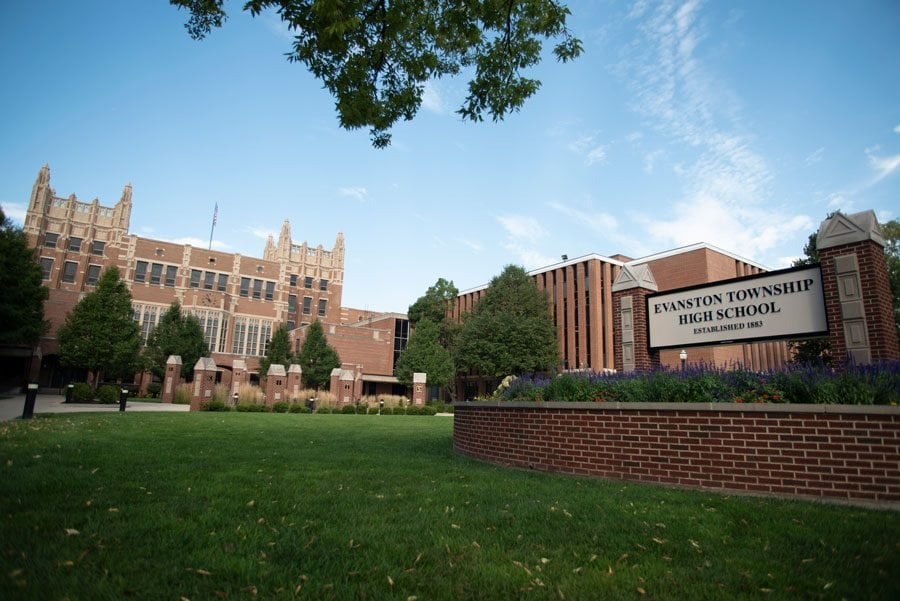Survey results reveal most ETHS students have little interaction with SROs
Evanston Township High School. The District 202 Board of Education discussed results from a survey on students’ feelings about school resource officers.
December 17, 2021
Evanston Township High School District 202 administrators presented results from a May survey on student feelings about school resource officers, or SROs, at the school at a Monday board of education meeting.
The national debate over SROs has led local districts to reevaluate their role within schools or remove them entirely — including ETHS. The presentation came before an Evanston Police Department School Resource Officer and ETHS safety staff recovered two handguns in the school on Thursday morning.
According to survey results, 2.3% percent of students said they had a negative experience with an SRO. Of the 69% of ETHS students that responded to the survey, the majority reported they hadn’t interacted with an SRO at the school.
The primary purpose of SROs at ETHS is “to protect students and staff from external threats such as a school shooter on campus,” according to the school’s website. Their law enforcement responsibilities include handling issues of discipline, but officers also spend about a third of their time in meetings, counseling students and giving class talks.
“The teachers, community members, representation from the board, staff members (and) safety department were really critical with providing meaningful information to understand what was needed to get a better understanding of the impact and the intent of our SRO program,” Associate Principal for Educational Services Keith Robinson said.
Many students had a difficult time distinguishing the resource officers from school safety staff, who are unarmed and serve a different role, said Director of Research, Evaluation & Assessment Carrie Levy. Safety officers’ responsibilities include monitoring entrances and visitor check-ins, providing security at school events, coordinating safety drills and arranging traffic safety services.
The survey also asked participants to imagine scenarios in which SROs dressed or behaved differently. When asked how they would feel if SROs wore a police uniform, 41.3% of students said they would feel somewhat or much more uncomfortable and 40.8% said they would feel neutral or not at all different. About 20% would feel more uncomfortable if SROs were present in the building more often.
Following the presentation, board member Pat Maunsell asked whether the committee had broken the data down by race. Levy responded the group had disaggregated it over the summer.
“We did look at it, we looked at the open-ended comments, all of it disaggregated by race and gender, and I do not recall seeing any differences,” Levy said.
However, Levy said she had not looked at these numbers since the spring, when she first presented them to the committee. Board President Pat Savage-Williams said she would like to know how Black students in particular feel about the SROs, and Levy said she will revisit the data.
The James B. Moran Center for Youth Advocacy, which provides community-based legal, social work and restorative services for youth and families in Evanston, also released its Reimagining School Safety report this week. The report urged ETHS to remove the school’s two SROs from campus.
The center’s report also included recent SRO arrest data from ETHS to illustrate the program’s disparate impact on students of color and students with disabilities, pushing them further into the school-to-prison pipeline. It also presents proven alternatives to building a safer, more restorative and racially equitable school community.
“There have been at least 30 arrests made on ETHS property,” said Moran Center Education Attorney Luca Guacci at a September District 202 meeting. “Although Black students at ETHS comprise approximately 25% of the population, they make up 77% of the arrests.”
Board member Mirah Anti said the data couldn’t tell her the information that began the discussion around ending the SRO program at ETHS.
“Part of the reason why we’re considering if there is a presence of an SRO continuing on comes after the wake of our summers and looking at violence on Black bodies,” Anti said. “I couldn’t begin to make a judgment call or support or step forward without understanding how our students are experiencing SROs based on identity, specifically looking at race.”
Several community members, including current ETHS students and staff, raised concerns during public comment about the impact SROs have on students in the district.
Sarah Bogan (ETHS ’16) spoke on behalf of Evanston Fight for Black Lives. When asked how they felt when seeing the SRO in the building, she said the highest number of students reported they felt “safe.” However, “anxious” also appeared clearly among their responses.
Bogan said EFBL suggests alternatives to police in schools that require a larger investment in social and emotional learning, transformative and restorative justice, more social workers and better intervention training.
“We encourage the school board to explore alternative models like the ones stated above to find ways to protect all students without harming our marginalized communities,” Bogan said.
Email: oliviaalexander2024@u.northwestern.edu
Twitter: @oliviagalex
Related Stories:



